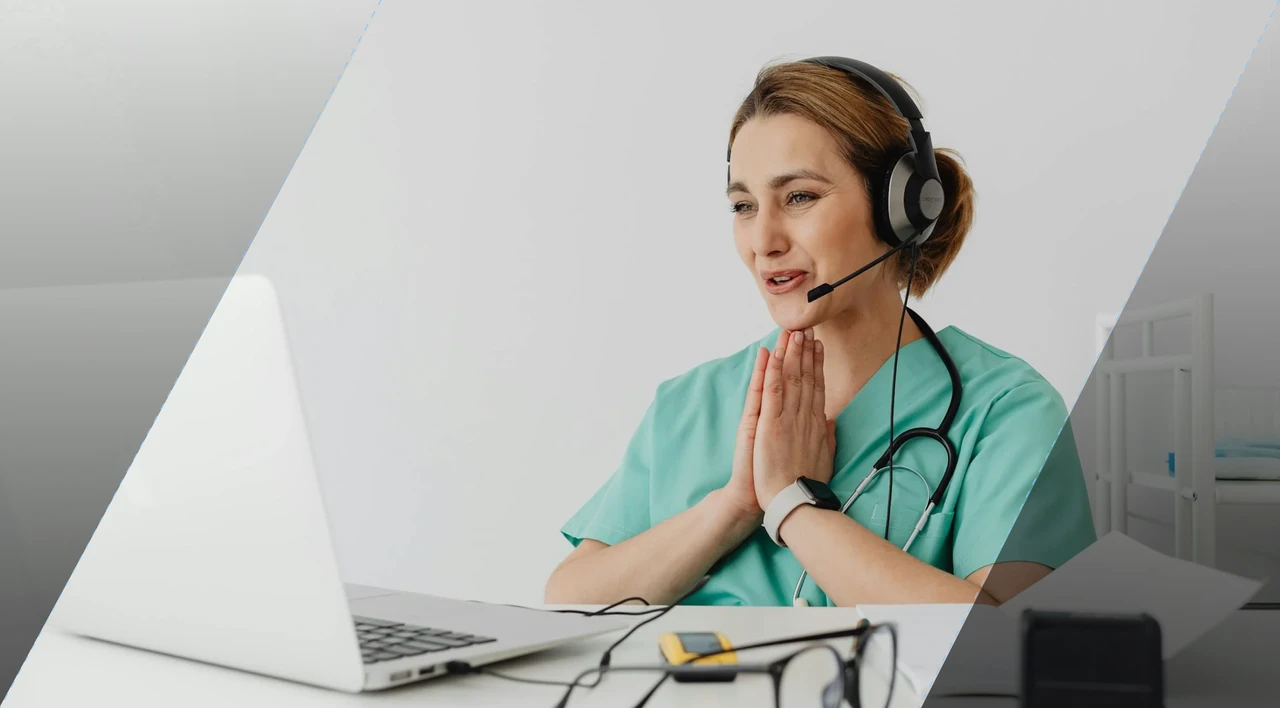SHARE
Exploring Popular Types of Healthcare Software Solutions

Contents
Contents
Welcome to our comprehensive guide on medical software solutions! In today’s rapidly evolving healthcare industry, technology plays a crucial role in enhancing patient care and streamlining operations. From electronic health records systems to telemedicine solutions, healthcare software has transformed the way medical professionals provide services.
In this article, we will dive deep into the different types of healthcare software and the pivotal role of healthcare software development companies in creating custom solutions for the healthcare sector. Whether you’re a healthcare provider or a technology enthusiast, understanding these software solutions will give you valuable insights into the digital transformation reshaping the healthcare landscape. So, let’s get started!
Key Takeaways:
- Electronic health records systems are digitizing patient data and enabling informed decision-making.
- Telemedicine and remote patient monitoring solutions are bringing healthcare to patients’ fingertips.
- Medical practice management software streamlines operations and enhances patient experiences.
- Hospital management systems are automating administrative tasks and improving financial operations.
Electronic Health Records (EHR) Systems
Electronic Health Record software is one of the most popular types of software used by hospitals and medical practices. By digitizing patient records, EHR software helps ease the healthcare professionals of manual handling by enabling instant access to critical information.
With EHR software, healthcare providers can securely store and manage patient data, including medical history, lab results, medications, and treatment plans. This centralized storage eliminates the need for physical paper records, reducing the risk of loss or damage.
Furthermore, EHR systems facilitate informed decision-making by providing comprehensive patient information at the point of care. Through intuitive interfaces, medical professionals can quickly retrieve and analyze patient data, allowing for personalized treatment plans and improved outcomes.
Integration of AI and Machine Learning in EHR Systems
The integration of artificial intelligence (AI) and machine learning algorithms in EHR systems further enhances their capabilities. AI algorithms can analyze large volumes of patient data, identifying patterns and generating insights that aid in diagnosis, treatment planning, and disease prevention. Machine learning algorithms can continuously learn and improve from the data, leading to more accurate predictions and proactive decision-making.
AI-powered EHR software can support doctors by offering predictive analytics, enabling medical staff to identify high-risk patients and intervene early. This predictive analysis can enhance preventive care, reduce hospital readmissions, and effectively allocate healthcare resources.
Overall, EHR systems combined with AI and machine learning are at the forefront of improving patient care and healthcare outcomes. The integration of technology in healthcare fosters innovation, efficiency, and personalized care.
Telemedicine and Remote Patient Monitoring (RPM) Solutions
Telemedicine and Remote Patient Monitoring (RPM) software are transforming the medical industry, with an expected market value of $459.8 billion by 2030. These technological solutions are redefining the way that patients access their healthcare, providing accessible and personalized medical services while optimizing healthcare workflows for improved efficiency and patient outcomes.
Telemedicine software enables medical practitioners to remotely give healthcare services through video consultations, eliminating the need for in-person visits. This not only saves time and travel costs but also increases access to healthcare, particularly for individuals in rural areas or with limited mobility.
RPM solutions take telemedicine a step further by enabling healthcare providers to remotely monitor patients’ vital stats in real time. By using wearable tech, such as smartwatches or fitness trackers, or even utilizing healthcare apps, doctors can track patients’ heart rate, blood pressure, and other important health indicators without the need for regular clinic visits.
These remote monitoring technologies not only improve convenience for patients but also allow doctors to detect potential health issues early on and intervene before they become serious. By continuously collecting and analyzing data, healthcare providers can identify trends, spot abnormalities, and make informed decisions regarding treatment plans.
The Benefits of Telemedicine and RPM Solutions
- Improved access to healthcare, especially for individuals in remote or underserved areas.
- Reduced costs and time spent on travel for in-person consultations.
- Enhanced convenience by enabling virtual consultations and remote monitoring.
- Early detection and intervention for potential health issues through real-time monitoring.
- Telemedicine works hand-in-hand with e-prescribing software, streamlining the prescription process for healthcare providers.
- Increased patient engagement and empowerment in managing their own health.
The Future of Virtual Healthcare
As technology continues to advance, telemedicine and RPM solutions are expected to play an increasingly important role in healthcare. The integration of artificial intelligence (AI) and data analytics can further enhance the accuracy and efficiency of remote patient monitoring software.
AI-powered algorithms can analyze patient data collected through wearable tech, identifying patterns and anomalies that may indicate potential health risks. This enables healthcare providers to intervene proactively, leading to improved patient outcomes.
In addition, the use of virtual reality (VR) and augmented reality (AR) in telemedicine can provide immersive experiences for patients and enhance the effectiveness of remote consultations. VR can be used for pain management or therapy sessions, while AR can assist surgeons during complex procedures.
With the growing adoption of telemedicine and RPM solutions, the healthcare industry is embracing digital transformation and paving the way for a more accessible, efficient, and patient-centric model of care.
Practice Management Software
Practice Management Software is a valuable tool for optimizing healthcare facility operations. It provides efficient solutions for managing appointments, gathering patient feedback, and improving overall operational efficiencies.
This type of software allows healthcare providers to streamline the scheduling process, minimizing errors and reducing patient wait times. With automated appointment reminders and real-time updates, healthcare organizations can ensure that patients receive timely care.
Benefits of Practice Management Software
Practice management software provides numerous benefits including:
- Streamlined appointment scheduling: Practice management software simplifies the appointment booking process, reducing administrative burden and improving patient experiences.
- Improved patient satisfaction: With the ability to gather patient feedback, healthcare facilities can identify areas for improvement and enhance patient satisfaction.
- Enhanced operational efficiency: Practice management software automates tasks such as billing, insurance claim processing, and inventory management, streamlining operations and reducing administrative overhead.
- Data-driven decision-making: Analytics provided by practice management software offer valuable insights into patient demographics, appointment patterns, and financial performance. This enables healthcare providers to make informed decisions and optimize resource allocation.
By leveraging practice management software and mobile apps, healthcare facilities can improve patient care, maximize operational efficiency, and enhance overall profitability. The analytics and patient feedback provided by these software solutions enable data-driven decision-making, leading to better patient outcomes and an improved healthcare experience.
Hospital Management Systems
Hospital Management Systems are essential tools that assist in the efficient management of hospitals and healthcare facilities. These comprehensive software solutions automate administrative tasks, streamline financial operations, and facilitate seamless patient communication. With Hospital Management Software, healthcare providers can optimize their operations, improve patient care, and enhance overall organizational efficiency.
Benefits of Hospital Management Systems
- Automation of administrative tasks such as appointments, admissions, and discharge processes, reducing manual errors and improving efficiency.
- Streamlined financial operations, including medical billing, invoicing, and insurance claims management, ensuring accurate and timely payments.
- Enhanced patient communication through a secure and user-friendly patient portal, enabling convenient access to medical records, appointment scheduling, and online consultations.
- Centralized view of hospital operations, providing real-time insights into patient records, inventory tracking, and resource allocation.
|
Key Features of Hospital Management Systems |
Benefits |
|
Automated appointment scheduling |
Reduces waiting times and improves the patient experience. |
|
Patient record management |
Enables comprehensive and secure access to patient information, facilitating informed decision-making. |
|
Inventory management |
Optimizes resource allocation, reduces wastage, and ensures efficient supply chain management. |
|
Financial operations |
Streamlines electronic medical billing, tracks payments, and simplifies insurance claims management. |
|
Reporting and analytics |
Provides valuable insights for informed decision-making, resource planning, and performance evaluation. |
With the automation and streamlining of administrative tasks, healthcare professionals can focus on providing personalized and efficient patient care, leading to better patient satisfaction and positive outcomes.
Medical Equipment Management Software
Medical Equipment Management Software (MEMS) is a crucial tool in healthcare facilities designed to streamline the management and maintenance of medical equipment. This specialized software is instrumental in ensuring the proper functioning, compliance, and optimal utilization of diverse medical devices and instruments.
One key feature of MEMS is its ability to centralize and automate equipment tracking. Healthcare providers can efficiently monitor the location, usage, and status of medical equipment across various departments. This helps prevent equipment loss, ensures timely maintenance, and aids in the rapid retrieval of necessary devices, promoting seamless workflow within healthcare facilities.
Moreover, MEMS plays a crucial role in regulatory compliance by maintaining a comprehensive record of equipment maintenance, calibration, and inspections. It assists healthcare institutions in adhering to industry standards and regulations, thereby mitigating risks and ensuring patient safety. The software often generates automated alerts and notifications for scheduled maintenance, reducing the likelihood of equipment failures and minimizing disruptions in medical services.
MEMS often integrates with other healthcare systems, such as Electronic Health Records (EHR) and Hospital Management Systems (HMS), fostering a cohesive and interconnected healthcare environment. This integration enables seamless data exchange, providing healthcare professionals with real-time information about equipment status and usage, and facilitating informed decision-making.
Medical Imaging and PACS
Medical imaging software and Picture Archiving and Communication Systems (PACS) have revolutionized the field of medical imaging, enabling healthcare professionals to collaborate in real-time and improving diagnostics and patient care. These advanced technologies leverage the power of AI and predictive analytics to enhance automated anomaly detection, providing more accurate and timely diagnoses.
Enhancing Real-Time Collaboration
Medical imaging software and PACS allow healthcare professionals to view, analyze, and share medical images and related data in real-time, regardless of geographical location. This real-time collaboration enables multidisciplinary teams to work together seamlessly, leveraging collective expertise and speeding up decision-making processes. With remote access capabilities, healthcare providers can consult with specialists and expedite the delivery of critical care.
AI and Predictive Analytics for Improved Diagnostics
Integration of AI and machine learning in medical imaging software and PACS enhances diagnostic accuracy and efficiency. AI algorithms can analyze vast amounts of medical image data to detect anomalies and potential diseases, assisting radiologists in making faster and more accurate diagnoses. Predictive analytics also play a crucial role in identifying patterns and trends, enabling proactive healthcare interventions and personalized treatment plans.
The Importance of Automated Anomaly Detection
Automated anomaly detection is a key feature of medical imaging software and PACS. By leveraging AI, these systems can automatically identify and flag abnormalities in medical images, allowing radiologists to focus on complex cases and reducing the risk of human error. This not only improves patient outcomes but also optimizes the use of healthcare resources, saving valuable time and costs.
Furthermore, medical imaging software and PACS streamline the workflow of radiology departments, enabling efficient image storage, retrieval, and sharing. With secure access to comprehensive patient data, healthcare professionals can gain valuable insights for better-informed decision-making and tailored treatment plans.
|
Benefits of Medical Imaging Software and PACS |
Impact on Healthcare |
|
Real-time collaboration and remote access capabilities |
Enhanced multidisciplinary teamwork and access to expert consultations |
|
Integration of AI and machine learning |
Improved diagnostic accuracy and faster decision-making |
|
Automated anomaly detection |
Reduction of human error and optimized resource utilization |
|
Efficient image storage, retrieval, and sharing |
Streamlined workflows and improved patient data management |
Pharmacy Management Software
Pharmacy Management Software is a comprehensive software system designed to optimize the operations of pharmacies and improve patient care. One key feature of this kind of software is its ability to automate prescription processing and medication dispensing. The software helps pharmacists manage prescription orders efficiently, reducing the likelihood of errors and ensuring timely dispensing of medications.
Integration with e-prescribing software and Electronic Health Records (EHR) allows seamless communication between healthcare providers and pharmacists, promoting accurate and up-to-date medication information. Additionally, the software often includes features for medication therapy management, helping pharmacists monitor patient medication adherence and provide valuable insights for personalized care.
Beyond prescription management, Pharmacy Management Software assists in inventory control by tracking medication stock levels, expiration dates, and order processes. This helps pharmacies optimize their inventory, reduce waste, and ensure that essential medications are always available for patients. The software also facilitates compliance with regulatory requirements, such as record-keeping and reporting, contributing to the overall effectiveness and regulatory compliance of pharmacy operations.
Conclusion
The digital transformation in healthcare has been accelerated by the implementation of healthcare software solutions. These solutions have revolutionized patient care and operational efficiency and enabled the healthcare industry to embrace the future. Custom software development companies have played a crucial role in creating tailor-made solutions to address the unique challenges faced by the healthcare sector.
By adopting healthcare software solutions, healthcare providers can enhance their efficiency, streamline workflows, and improve patient outcomes. These solutions enable seamless integration of patient data, automate administrative tasks, and facilitate real-time collaboration among healthcare professionals. The use of AI and machine learning in healthcare software solutions further enhances predictive analytics and automated anomaly detection, leading to more accurate diagnoses and personalized care.
As the digital transformation in healthcare continues to evolve, embracing custom software development will play a critical role in shaping the future of healthcare.
Frequently Asked Questions
What are the popular types of healthcare software solutions?
The popular types of medical software solutions include electronic health record (EHR) software, medical billing software, electronic medical record (EMR) management, telemedicine software, health record software, and medical diagnosis software.
How is healthcare software used in the healthcare industry?
Healthcare software is used in the healthcare industry for a variety of purposes such as managing patient information, streamlining medical billing and claims processing, facilitating telemedicine consultations, and improving medical diagnosis and treatment planning.
What is the role of healthcare software in medical billing?
Healthcare software plays a crucial role in medical billing by automating the billing process, streamlining claims submission, managing patient billing information, and ensuring compliance with healthcare coding and billing regulations.
How does healthcare software enable telemedicine services?
Healthcare software enables telemedicine services by providing secure communication channels for remote consultations, virtual appointment scheduling, real-time video conferencing, and electronic prescription management.
What are the benefits of using healthcare software in healthcare services?
Using healthcare software in healthcare services offers benefits such as improved operational efficiency, enhanced patient care coordination, streamlined administrative processes, and better access to medical data for informed decision-making.
What are the security measures in place for healthcare software solutions?
Security measures for healthcare software solutions include data encryption, access controls, compliance with healthcare privacy regulations (such as HIPAA), regular security audits, and protection against cyber threats and breaches.
How is healthcare software used in hospitals and clinics?
Healthcare software is used in hospitals and clinics for health management, patient scheduling and registration, medical imaging and visualization, inventory and equipment management, and facilitating communication among healthcare staff.
Expert Healthcare Software Development Services
Flatirons provides top-rated healthcare software development services.
Get the CEO's Take
Handpicked tech insights and trends from our CEO.
Expert Healthcare Software Development Services
Flatirons provides top-rated healthcare software development services.
Get the CEO's Take
Handpicked tech insights and trends from our CEO.

Record Information System (RIS) for Healthcare Data Management
Flatirons
Jul 02, 2025
Healthcare BPO Services: Streamlining Medical Operations
Flatirons
Jun 28, 2025
Patient Management System Software | Streamline Patient Care
Flatirons
May 01, 2025
CRM for Healthcare – Streamlined Patient Management
Flatirons
Jan 29, 2025
Streamline Your Healthcare Practice with EHR Integration
Flatirons
Nov 18, 2024
Top Mobile App Development Companies in California for 2025
Flatirons
Oct 29, 2024